How to Grow Basil Indoors: A Complete Guide for Lush, Flavorful Herbs
- February 19, 2024
- 0 comment
Basil, a fragrant and flavorful herb, is a staple in many kitchens. Renowned for its fresh taste and aromatic presence, it’s a key ingredient in cuisines worldwide. Growing basil indoors allows you to enjoy this herb throughout the year, regardless of the weather outside. This guide will walk you through the steps to cultivate healthy, thriving basil plants in your home.
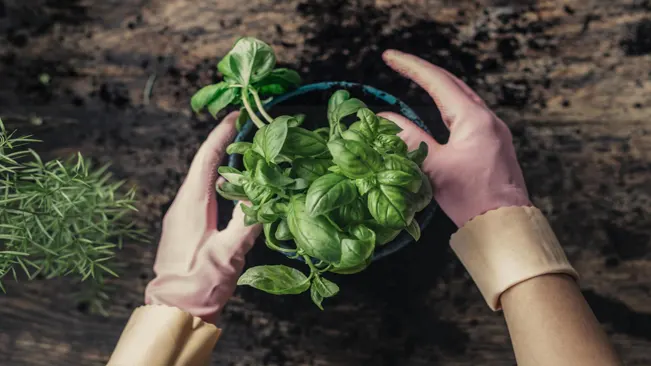
Choosing Your Basil Variety
There are several varieties of basil, each with unique flavors and appearances. Some popular types include Sweet Basil, Thai Basil, and Purple Basil. Consider your culinary needs and personal preferences when selecting a variety.
Sweet Basil
This is the most common variety, often seen in Italian dishes. It has large, green leaves and a classic, peppery flavor with hints of sweetness. Sweet basil is perfect for pesto, Caprese salads, and as a fresh addition to pizzas and pasta.
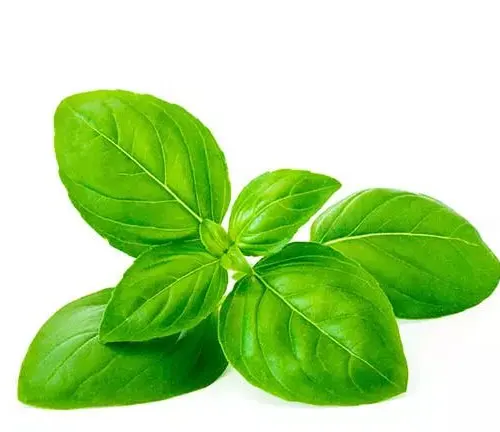
Thai Basil
Known for its robust flavor, Thai basil has a licorice-like taste and a slightly spicy edge. It features smaller, narrower leaves with purple stems and often purple flowers. This variety is a staple in Southeast Asian cuisine, particularly Thai and Vietnamese dishes. It’s excellent in stir-fries, curries, and as a fresh garnish on noodle dishes.

Purple Basil
Distinctive for its deep purple leaves, this variety adds a pop of color to your garden and dishes. Purple basil has a slightly less sweet flavor compared to sweet basil, with a more intense clove-like aroma. It’s not just beautiful; it’s also tasty in salads, as a garnish, and in infused vinegars.
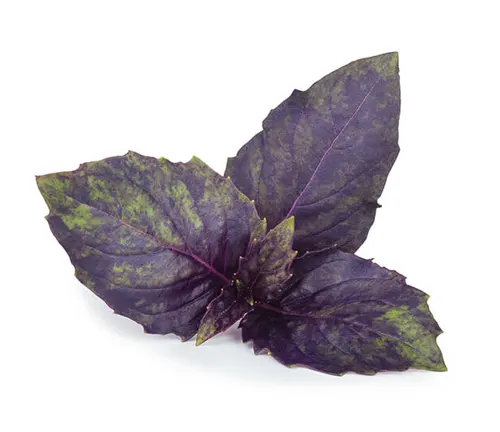
Lemon Basil
As the name suggests, this variety has a zesty, citrusy aroma and flavor, with smaller, light green leaves. Lemon basil pairs wonderfully with fish, chicken, and in fruit salads. It’s also a lovely herb for making herbal teas or infusing oils.
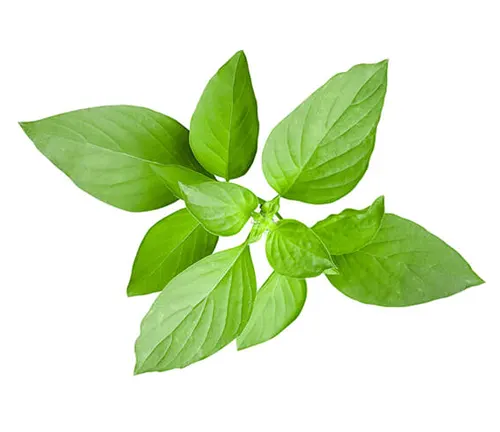
Cinnamon Basil
This type of basil has a unique, spicy aroma reminiscent of cinnamon, with small, narrow leaves and pink flowers. It adds a warm, spicy note to dishes and is great in desserts, teas, and cocktails.
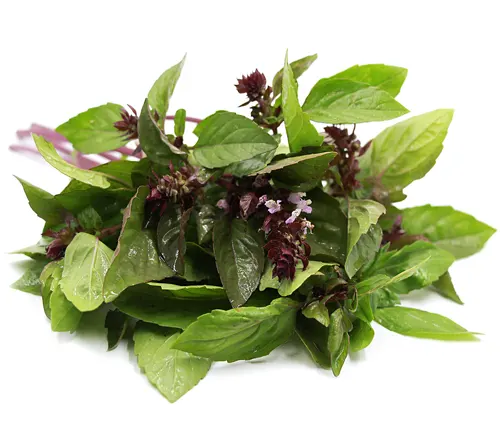
Genovese Basil
Similar to sweet basil but with a more intense flavor, Genovese basil is the go-to variety for authentic Italian pesto. It has large, wrinkled leaves that are rich in essential oils, contributing to its strong aroma and taste.
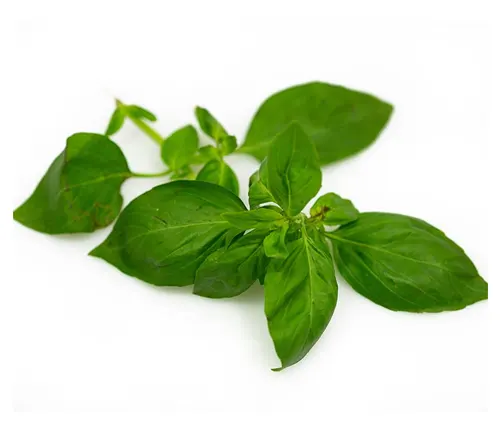
Greek Basil
Known for its compact growth habit, Greek basil has small leaves and a strong aroma. It’s less sweet than other varieties and is often used in Mediterranean cuisine, especially in salads, soups, and as a garnish.
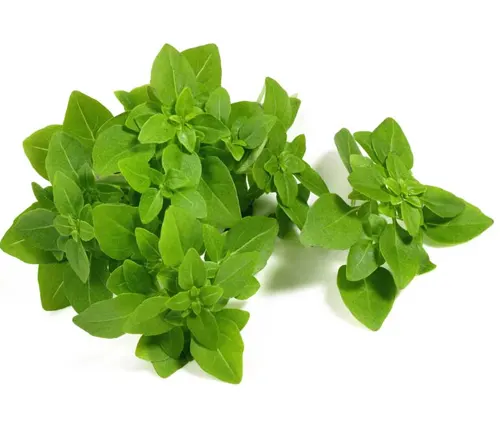
Starting from Seeds or Seedlings
Basil can be grown from seeds or purchased as seedlings. Seeds offer more variety and are cost-effective, while seedlings provide a quicker start. If starting from seeds, plant them in a moist, seed-starting mix and keep them warm until germination.
Starting Basil from Seeds
- Seed Selection
When choosing basil seeds, consider the variety that best suits your taste and cooking needs. There are numerous varieties available, each with distinct flavors and growth habits.
Seed Starting Mix
Use a light, well-draining seed starting mix. This type of mix provides the right balance of moisture retention and aeration, crucial for seed germination.

Sowing Seeds
Plant the basil seeds about 1/4 inch deep in the soil. You can either sow them in individual pots or in a larger tray if you plan to transplant them later. Space the seeds a few inches apart to give each seedling room to grow.
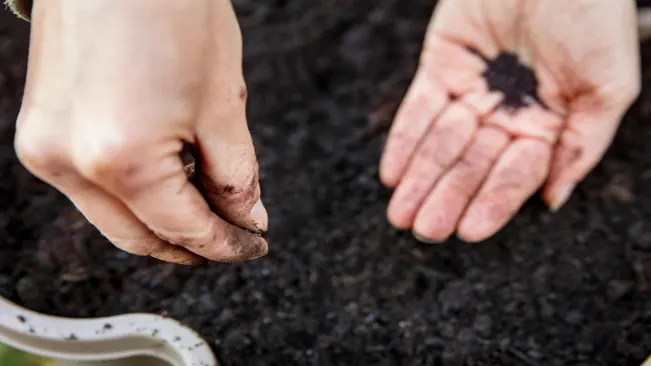
Moisture and Warmth
After sowing, gently water the soil, ensuring it’s moist but not waterlogged. Basil seeds need consistent warmth to germinate, ideally between 70°F and 75°F. You can use a heat mat to maintain a steady temperature.
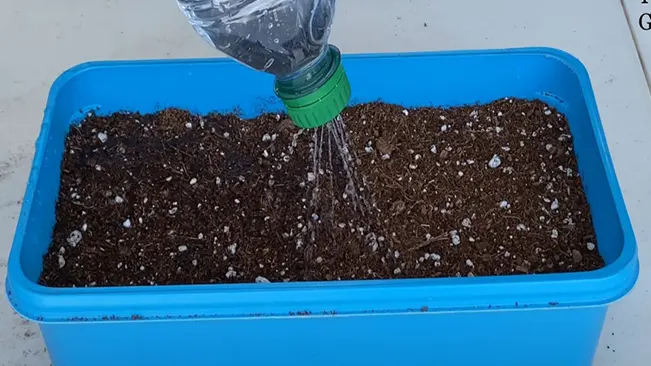
Light
While light isn’t necessary for germination, once seedlings emerge, they need plenty of light to grow strong. Place them in a sunny window or under grow lights for about 14-16 hours per day.
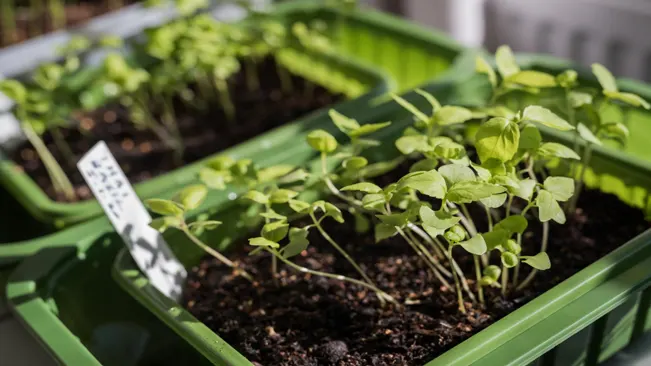
- Germination Time
Basil seeds typically germinate within 5 to 10 days, depending on the variety and growing conditions.
Thinning Seedlings
Once the seedlings have a couple of sets of true leaves, thin them out, leaving the strongest seedling in each pot or spacing them about 2-3 inches apart in trays.
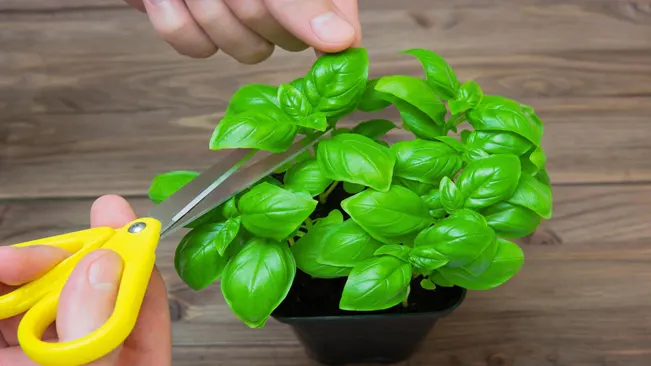
Starting Basil from Seedlings
Choosing Seedlings
When purchasing basil seedlings, look for healthy, vibrant plants. Avoid those with yellowing leaves or signs of pest damage.

Transplanting
If the seedlings are in a nursery tray, transplant them into individual pots or your final growing container. This should be done carefully to avoid damaging the delicate roots.
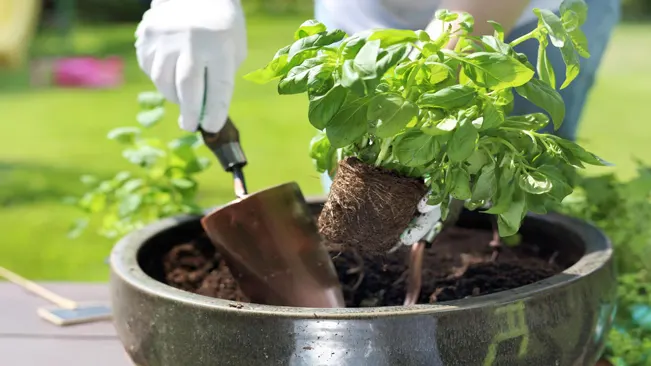
- Acclimation
If the seedlings were grown in a greenhouse, they might need to be acclimated to your home environment. Gradually introduce them to the light and temperature conditions where they will ultimately grow. - Initial Care
After transplanting, water the seedlings well and place them in a location where they’ll receive ample sunlight. Monitor them closely for the first few days to ensure they are adapting well.
Potting and Soil Requirements
Choose a pot with good drainage and use a high-quality potting mix. Basil thrives in nutrient-rich, well-draining soil. Ensure the pot is large enough to accommodate the basil’s growth, usually about 8-10 inches in diameter.
Choosing the Right Pot
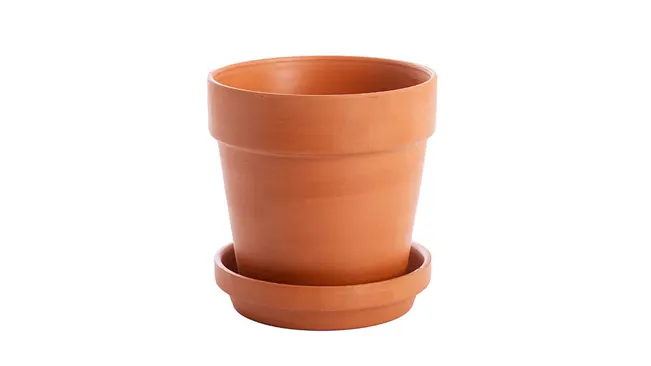
- Size Matters: Basil plants need room to grow, both above and below the soil. A pot that’s 8-10 inches in diameter is ideal for a single basil plant. This size provides ample space for root development, which is crucial for healthy growth.
- Drainage is Key: Ensure your pot has adequate drainage holes. Basil does not like to sit in waterlogged soil, as this can lead to root rot and other issues. A pot with one or more drainage holes at the bottom is essential.
- Material Considerations: Pots can be made from various materials like plastic, terracotta, or ceramic. Terracotta pots are porous, which allows the soil to breathe and helps prevent overwatering. However, they can dry out more quickly than plastic or glazed ceramic pots. Choose a material based on your watering habits and the humidity in your home.
Selecting the Right Soil
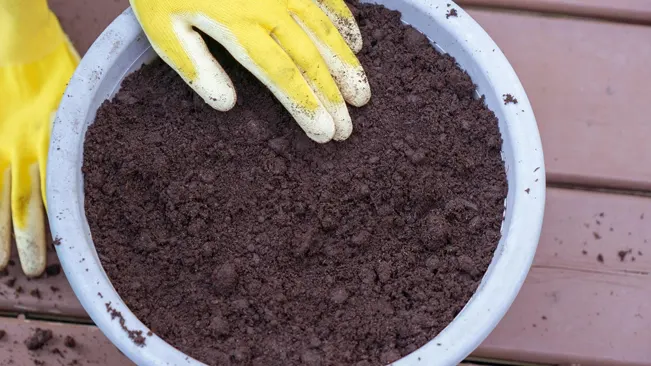
- Well-Draining Potting Mix: Basil thrives in well-draining soil. Choose a high-quality potting mix that is designed for container gardening. These mixes usually contain a blend of peat moss, vermiculite, and perlite, which help with drainage and aeration.
- Nutrient-Rich: Basil is a fast-growing herb that needs plenty of nutrients. Look for a potting mix that is enriched with compost or other organic matter. You can also amend your potting mix with compost or a slow-release organic fertilizer to boost nutrient levels.
- pH Levels: Basil prefers a slightly acidic to neutral soil pH, typically between 6.0 and 7.0. Most high-quality potting mixes will fall within this range.
Optimal Lighting Conditions
Basil requires plenty of sunlight. Place your basil in a south-facing window where it can receive at least six hours of sunlight daily. If sufficient natural light is not available, consider using grow lights to supplement.
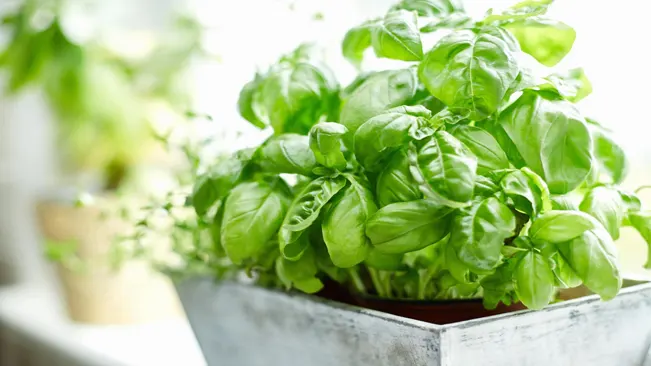
- Sunlight Requirements: Ideally, basil needs about 6 to 8 hours of sunlight per day. This can be achieved by placing your basil plants near a south-facing window, which tends to receive the most sunlight throughout the day. If you live in the Northern Hemisphere, south-facing windows are typically the sunniest. In the Southern Hemisphere, this would be north-facing windows.
- Quality of Light: The quality of sunlight is also important. Direct sunlight is preferred, but too much harsh sunlight can sometimes scorch the leaves, especially in hot climates. If you notice the leaves turning yellow or brown, or if they look scorched, it may be necessary to filter the light slightly or move the plant to a location with less direct exposure.
- Using Grow Lights: In regions with less natural sunlight or during winter months, grow lights can be a great supplement. LED or fluorescent grow lights are the most efficient and effective. They should be placed a few inches above the top of the plant and moved up as the plant grows. The lights should be on for about 10-12 hours a day to mimic natural sunlight conditions.
- Light Intensity and Duration: The intensity of the light and duration can affect the growth and flavor of basil. Insufficient light can lead to leggy plants, with long stems and few leaves, which is a sign of the plant stretching towards the light source. In contrast, sufficient light encourages bushier growth and enhances the flavor of the leaves.
- Rotating the Plant: It’s a good practice to rotate your basil plant regularly to ensure that all sides receive equal light. This prevents the plant from leaning towards the light source and promotes even growth.
- Observing the Plant: Pay attention to your basil’s appearance. If it appears leggy, pale, or weak, it may need more light. On the other hand, leaves that look dry, scorched, or discolored might be receiving too much direct sunlight.
Watering Your Basil Plants
Water basil when the top inch of soil feels dry. Avoid overwatering, as basil does not like to sit in soggy soil. Ensure the pot allows excess water to drain to prevent root rot.
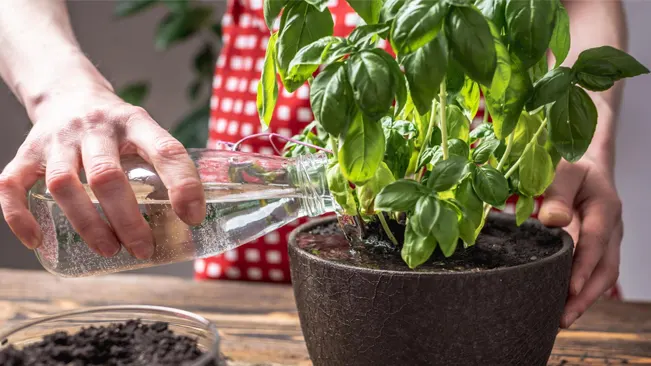
- Checking Soil Moisture
Before watering your basil, check the soil moisture. The best way to do this is by inserting your finger into the soil up to the first knuckle (about an inch deep). If the soil at this depth feels dry, it’s time to water your plant. If it still feels moist, wait a day or two and check again. - Frequency of Watering
The frequency of watering depends on several factors, including the size of the plant, the size of the pot, the type of soil, the climate, and the time of year. Generally, basil plants need to be watered every few days. However, in hot, dry conditions, they may require daily watering, while in cooler, less sunny conditions, they may need water less frequently. - Amount of Water
When you water your basil, do so thoroughly. This means watering until you see water begin to run out of the drainage holes at the bottom of the pot. This ensures that the entire root system gets moisture. After watering, allow the excess water to drain away completely. Do not let the pot sit in standing water as this can lead to root rot. - Type of Water
Use room-temperature water for your basil plants. Cold water can shock the roots, especially in a warm indoor environment. If your tap water is heavily treated or contains high levels of minerals, consider using filtered or distilled water to avoid buildup in the soil. - Watering Technique
Water at the base of the plant, rather than from above. This helps prevent fungal diseases by keeping the leaves dry. It also ensures that the water goes directly to the roots, where it’s needed. - Adjusting to the Plant’s Need
Be adaptable in your watering routine. Basil plants can become more or less thirsty as they grow or as environmental conditions change. Pay attention to the plant’s appearance: leaves that are wilting or turning yellow may indicate watering issues. - Monitoring for Overwatering and Underwatering
Signs of overwatering include yellowing leaves, a musty smell from the soil, and a general look of sogginess. Underwatered basil, on the other hand, will have dry, brittle, or drooping leaves. Adjust your watering practices accordingly if you notice these signs.
Temperature and Humidity Considerations
Basil prefers a warm environment, ideally between 70°F and 80°F. Protect the plant from cold drafts and extreme temperature fluctuations. While basil doesn’t require high humidity, it can benefit from occasional misting.
Temperature Considerations for Basil
- Ideal Range: Basil thrives in a warm environment. The optimal temperature range for basil is between 70°F and 80°F (21°C to 27°C). This range is crucial for promoting healthy growth and maximizing flavor. Basil is sensitive to cold, and temperatures dropping below 50°F (10°C) can harm or even kill the plant.
- Avoiding Temperature Fluctuations: Basil plants can be stressed by sudden changes in temperature. It’s important to keep them away from sources of drafts such as open windows, air conditioning vents, or heaters. Consistent temperatures help the plant maintain steady growth.
- Protection from Cold: If you live in a cooler climate or if your home tends to be on the cooler side, you might need to take extra steps to ensure your basil’s warmth. This could include positioning the plant in a warmer room, away from windows during cold nights, or even using a plant heating mat to maintain soil temperature.
Humidity Considerations for Basil
- Moderate Humidity Levels: Basil doesn’t require high humidity, but it does best in moderate humidity environments. If the air in your home is particularly dry, especially during winter months with indoor heating, your basil might need additional humidity.
- Benefits of Misting: Misting your basil plants can help increase the humidity around them, particularly in dry conditions. However, it’s important to not overdo it as basil doesn’t like to be too wet. A light misting every now and then should suffice.
- Using a Humidity Tray: Another way to increase humidity is to use a humidity tray. Place water and pebbles in a shallow tray and set the basil pot on top of the pebbles. As the water evaporates, it increases the humidity around the plant. This method also prevents the roots from sitting in water, which can cause root rot.
- Monitoring Humidity Levels: If you are serious about maintaining optimal growing conditions, you might consider using a hygrometer to monitor the humidity levels in your basil plant’s environment. This can help you make more informed decisions about when to mist or adjust the plant’s surroundings.
Fertilizing for Growth
Feed your basil plant with a balanced, water-soluble fertilizer every 4-6 weeks during the growing season. This will help promote lush, healthy growth.
Understanding Fertilizer Types
- Balanced Fertilizer: A balanced fertilizer has equal proportions of the three primary nutrients: Nitrogen (N), Phosphorus (P), and Potassium (K). These are usually represented by a ratio such as 10-10-10 or 20-20-20 on fertilizer packages. Nitrogen supports leafy growth, phosphorus aids in root development, and potassium contributes to overall plant health.
- Water-Soluble Fertilizers: These fertilizers are dissolved in water and applied to the soil. They are quickly absorbed by the plant, making them an ideal choice for providing immediate nutrients. This is particularly beneficial for fast-growing plants like basil.
Frequency of Fertilization
- Basil plants should be fertilized every 4-6 weeks during their active growing season, typically spring and summer. This regular feeding schedule supports continuous growth and leaf production.
How to Fertilize
- Dilution is Key: Always dilute the fertilizer according to the manufacturer’s instructions. Over-fertilization can lead to nutrient burn, which damages the plant.
- Application: Apply the diluted fertilizer to the soil, not directly onto the basil leaves. This ensures that the roots absorb the nutrients effectively.
- Watering Before Fertilizing: It’s a good practice to water your basil plant lightly before applying fertilizer. This prevents the roots from absorbing too much fertilizer too quickly, which can be harmful.
- Organic Options
If you prefer organic gardening, there are organic fertilizer options available. These include fish emulsion, seaweed extracts, and compost teas. Organic fertilizers release nutrients more slowly and are less likely to cause over-fertilization issues.
Monitoring Plant Response
Observe your basil plant after fertilization. Healthy growth, vibrant green leaves, and robust stems indicate that the fertilization routine is working well. If you notice yellowing leaves, stunted growth, or leaf burn, it may be a sign of over-fertilization.
Adjusting for Indoor Conditions
- Since indoor plants, including basil, often grow at a slower pace than outdoor plants, they may require less fertilizer. Monitor your plant’s response and adjust the frequency and strength of fertilization accordingly.
Seasonal Adjustments
Reduce or stop fertilizing in the fall and winter when the basil’s growth naturally slows down. Over-fertilizing during these months can do more harm than good.
Pruning and Harvesting
Regular pruning encourages bushier growth and prevents flowering, which can alter the flavor. Pinch off the top leaves once the plant reaches about 6 inches in height. Harvest leaves as needed, but never remove more than one-third of the plant at a time.
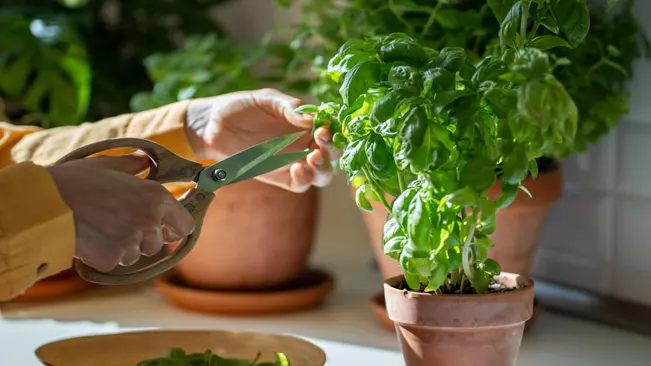
- When to Start Pruning: Begin pruning when your basil plant has at least six sets of leaves or is about six inches tall. This is usually a few weeks after planting.
- How to Prune: Use your fingers or a pair of clean, sharp scissors to pinch off the top set of leaves, right above a leaf node (where leaves grow out of the stem). This action stimulates the plant to produce two new stems from that node.
- Regular Maintenance: Continue to prune regularly, focusing on the top leaves and any flowers that start to form. Basil plants have a tendency to bolt (flower), especially in hot weather. Removing flowers as soon as they appear redirects the plant’s energy back into leaf growth. Flowering can cause the leaves to develop a bitter taste.
Harvesting Your Basil
Harvesting basil is not only beneficial for your cooking but also promotes new growth on the plant. Here’s how to harvest basil effectively:
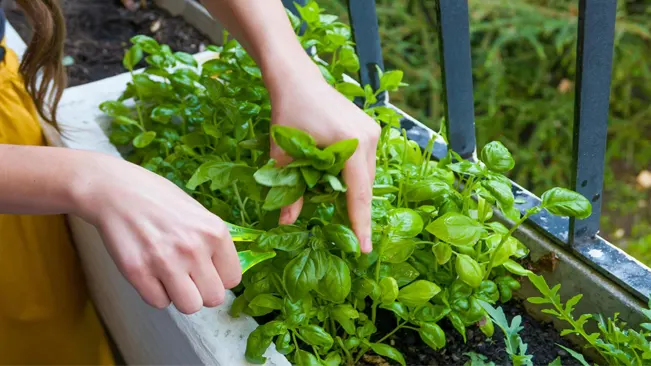
- When to Harvest: The best time to harvest is in the morning when the plant’s oils are at their peak, resulting in more flavorful leaves.
- How to Harvest: Similar to pruning, harvest the leaves from the top down, cutting just above a leaf pair or node. Always leave several sets of leaves on the lower part of the stem to ensure the plant can continue to grow and produce more leaves.
- How Much to Harvest: A good rule of thumb is to never take more than one-third of the plant’s total foliage at once. Over-harvesting can stress the plant and hinder its growth.
- Frequent Harvesting: Regular harvesting encourages the plant to grow fuller and produce more leaves. Even if you don’t need the leaves, it’s beneficial to prune and harvest regularly.
Storing Harvested Basil
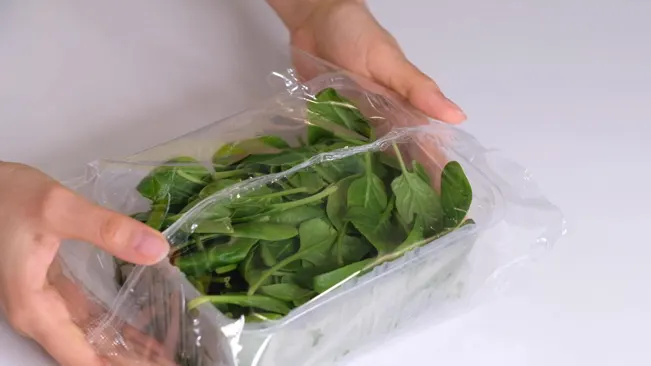
After harvesting, you can either use the basil leaves fresh or store them for later use. To keep basil fresh, you can place the stems in a glass of water, like a bouquet, and keep them on the countertop. For longer storage, basil can be dried or frozen. Freezing is often preferred as it better preserves the herb’s flavor and aroma.
Pest and Disease Management
Inspect your basil plants regularly for signs of pests or disease. Common issues include aphids and mildew. Address problems early with organic pesticides or fungicides and by improving air circulation around the plant.
Common Pests
- Aphids: These small, soft-bodied insects can be green, yellow, brown, red, or black. They typically cluster on the undersides of leaves and stems, sucking sap and weakening the plant. Aphids can also spread viruses.
- Spider Mites: These tiny pests, often red or brown, are hard to see with the naked eye. They cause yellow or white speckles on leaves by sucking plant juices. In severe cases, they can cover the plant in fine webs.
- Whiteflies: These small, winged insects cluster on the undersides of leaves. Like aphids, they suck sap and can cause yellowing or wilting.
Common Diseases
- Basil Downy Mildew: This fungal disease appears as yellow patches on the upper side of the leaves and a grey, fuzzy growth on the underside. It thrives in humid conditions.
- Fusarium Wilt: This soil-borne fungus causes wilting and yellowing of leaves, starting with the lower leaves and moving upward. It can eventually kill the plant.
Prevention and Control
- Inspect Regularly: Regularly check your basil plants for signs of pests and diseases, paying close attention to the undersides of leaves.
- Maintain Good Air Circulation: Ensure your plants aren’t overcrowded and have good airflow. This reduces the humidity around the plant, making it less inviting to pests and fungal diseases.
- Adequate Watering: Overwatering can contribute to fungal diseases. Water basil when the top inch of the soil is dry, and ensure the pot has good drainage.
- Organic Pest Control: If pests are spotted, try natural solutions first. Neem oil, insecticidal soaps, and horticultural oils are effective against many pests and are less harmful to beneficial insects.
- Fungal Disease Management: For diseases like downy mildew, removing affected leaves can help. For more severe cases, organic fungicides based on copper or sulfur can be used. Always follow the instructions on the product label.
- Healthy Soil Practices: Using sterile potting soil and clean pots can prevent many diseases. Avoid reusing soil where diseased plants have grown.
Beneficial Insects and Companion Planting
- Introducing beneficial insects like ladybugs can help control aphid populations.
- Companion planting with plants that repel pests, such as marigolds or chives, can also be an effective preventive strategy.
Propagation
Propagate basil by taking stem cuttings and placing them in water until roots develop. This is an easy way to multiply your basil plants.
Basil Propagation
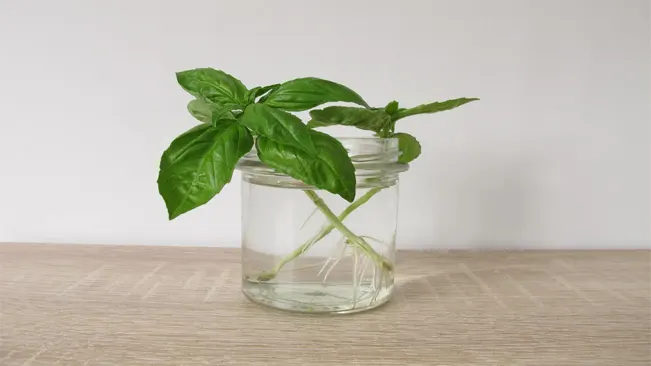
- Selecting the Cutting
Choose a robust, 4-6 inches long stem from a healthy basil plant. - Preparing the Cutting
Cut just below a leaf node using clean scissors. Remove lower leaves, leaving top leaves intact. - Rooting in Water
Submerge the stem (not leaves) in water in a container. Change water every few days to prevent bacteria. - Monitoring Root Growth
Keep in indirect sunlight. Roots usually appear in 1-2 weeks; wait until they’re 1-2 inches long. - Planting the Rooted Cutting
Plant in a pot with drainage holes using quality potting mix. Place the cutting in a small hole and gently cover with soil. - Aftercare
Water well, keep soil moist but not wet, and ensure at least six hours of daily sunlight.
Conclusion
Growing basil indoors is a rewarding endeavor that enhances your cooking and offers the joy of gardening within your home. By providing the right conditions and care, you can enjoy a continuous supply of fresh basil all year round. Happy growing!
FAQs (Frequently Asked Questions)
- What type of soil is best for growing basil indoors?
Basil prefers well-draining, nutrient-rich potting soil. A mix designed for vegetables or herbs works well. - How much sunlight does indoor basil need?
Basil requires at least six hours of sunlight per day. A south-facing window is ideal. If natural light is insufficient, consider using grow lights. - How often should I water indoor basil?
Water when the top inch of soil feels dry. Basil likes moisture but is sensitive to overwatering, so avoid letting it sit in soggy soil. - What is the ideal temperature for growing basil indoors?
Basil thrives in warm conditions, ideally between 70°F and 80°F (21°C to 27°C). Protect it from cold drafts and sudden temperature changes. - Can I grow basil indoors year-round?
Yes, with adequate light and warmth, you can grow basil indoors throughout the year. - How do I fertilize indoor basil plants? Use a balanced, water-soluble fertilizer every 4-6 weeks during the growing season. Avoid over-fertilizing, which can harm the plant.
- When and how should I prune my basil plant? Start pruning when the plant is about 6 inches tall. Pinch off the top set of leaves to encourage bushier growth and prevent early flowering.
- Can I propagate basil indoors?
Yes, basil can be easily propagated from stem cuttings. Place a 4-6 inch cutting in water until roots develop, then plant in soil. - What pests and diseases should I watch out for?
Common issues include aphids and fungal diseases like mildew. Inspect regularly and treat promptly with organic pesticides or fungicides if needed. - How do I harvest basil without harming the plant? Harvest leaves or whole stems as needed, but never remove more than one-third of the plant at a time. This encourages new growth and keeps the plant healthy.

Kristine Moore
Forestry AuthorI'm Kristine Moore, a seasoned garden landscaping professional with over 30 years of experience. My extensive career has been dedicated to transforming outdoor spaces into stunning, sustainable landscapes. With a deep understanding of horticulture, design principles, and environmental stewardship, I have become a respected figure in the field, known for creating harmonious, visually appealing, and eco-friendly gardens. My commitment to excellence and continuous learning in landscaping trends and techniques has solidified my reputation as an expert in garden design and implementation.

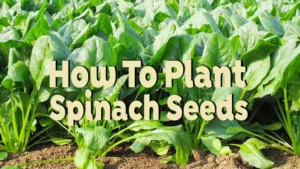
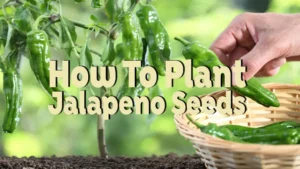
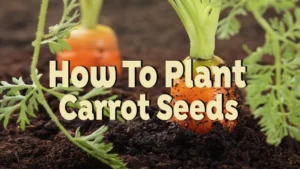

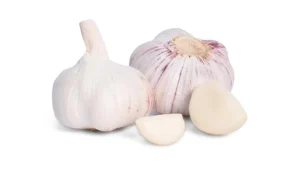
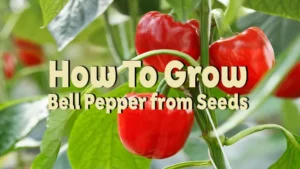


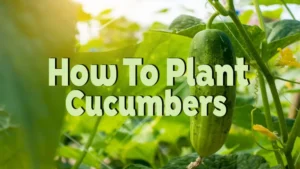
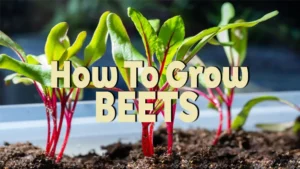
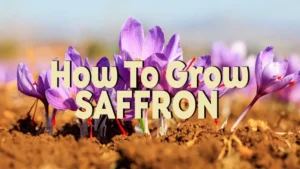

Leave your comment